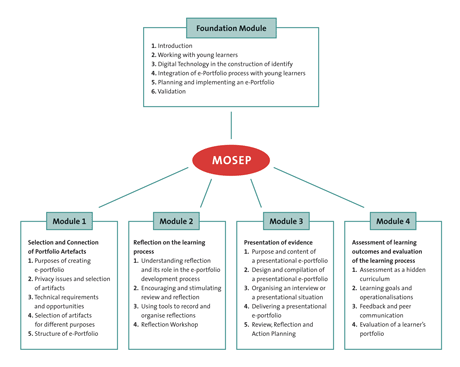by Wolf Hilzensauer
Some hail e-portfolios as the answer to their prayers for a method of competence-oriented learning. This is because e-portfolios combine classical (course-oriented and/or blended) e-learning with self-organized, self-oriented and lifelong learning. What competencies do teachers need in order to support learners in their individual learning processes? The European project MOSEP (more self esteem with my e-portfolio) tries to come up with some of the answers.
The search for supportive tools and strategies for learning is as old as learning itself. According to Cohn & Hibbits (Beyond the Electronic Portfolio: A Lifetime Personal Webspace, EDUCAUSE QUARTERLY, Number 4, 2004, pp 7- 10) 'knowledgeable slaves' had to accompany Roman boys in ancient times to school, to support them in their learning and to help them memorize the schoolwork they had done. In the 1940s, Vannevar Bush developed the idea of a 'memex', an electronic system which would automatically link related pieces of information in order that they might be stored in a meaningful way. In today's literature also, tools to support thinking are imagined. For instance, Albus Dumbledore, headmaster in J.K. Rowling's Harry Potter series, uses a thing called a 'pensieve', which is used to store unimportant thoughts so that he can concentrate on the important ones. If they are needed later, he can recall them, giving him the ability to focus his mind.
E-portfolios can be defined as "a purposeful collection of student (or teacher) work that illustrates efforts, progress and achievement in one or more areas over time. An electronic portfolio uses digital technologies, allowing the portfolio developer to collect and organize portfolio artifacts in many media types (audio, video, graphics, text)." (Barrett, 2005)
When working with e-portfolios, the focus (contrary to classical learning management systems) lies in the combination of storing both the products and the process of learning. The documentation of learning processes is achieved by recording reflections on the learning progress of individuals.
Implementing e-Portfolios in an Educational Context
When working with e-portfolios in an educational context, it is important to not only introduce the method (and an appropriate tool), but to also implement e-portfolios as an overall concept. In doing so, one must consider the existing curricular system, the objectives of the educational context (targets and outcomes) and the technological and organizational requirements. In addition (and this is the MOSEP idea), teachers and tutors require specific skills and must adapt their classical teaching methods to create an open, flexible learning partnership between teacher/ tutor and learner.

MOSEP: The E-portfolio Course for Teachers and Vocational Counsellors
MOSEP is a European project, funded by the Leonardo da Vinci Programme (Pilot Projects II - Duration: 2006-2008). The project is harnessing the power of e-portfolios to support young people and the teaching and counselling staff who work with them. A strong European partnership - from Austria, Bulgaria, France, Germany, Lithuania, Poland and the UK - is working closely with a network of experts across Europe to produce an e-portfolio 'toolkit' specifically designed for initial and in-service teacher trainers and vocational counsellors.
Our newly developed didactic approach provides a set of self-explanatory training material, which can be used, reused and adapted according to an institution's needs. All materials are freely and openly available via a Wiki system, which provides semantically enhanced resources, a guided tour, a predefined pathway through the system, and trainer guidelines and multimedia resources.
The MOSEP Toolkit
The following products will be available for use by schools and organizations responsible for teacher training and vocational counselling:
- a study outlining the qualifications and skills required by teachers/tutors working with adolescent learners
- the MOSEP e-portfolio course for teachers/tutors and vocational counsellors
- a teacher-training package providing guidelines and assignments that teachers can use with their students
- an online forum for teachers/tutors providing help in the use of this material and in the selection, installation and implementation of an open-source e-portfolio tool for their students.
Future Steps
Beginning in autumn 2007, the testing period will be used to evaluate the MOSEP course in five different countries and in five different languages: English, German, Polish, Lithuanian and Bulgarian. All materials will be translated and adapted, revised and finalized by spring 2008. The final conference will take place in June 2008 in Salzburg, where the results will be presented, and the future development of e-portfolios and the concept of self-directed and lifelong learning will be discussed.
Links:
http://edumedia.salzburgresearch.at
http://www.mosep.org
Barrett, H. (2005). Portfolios For Learning:
http://electronicportfolios.org/blog/2005_05_01_eportfolios_archive.html
The MOSEP Study: Grab your future with an e-portfolio:
http://www.mosep.org/study
Please contact:
Wolf Hilzensauer
Salzburg Research Forschungsgesellschaft, EduMedia Group, Austria
Tel: +43 662 2288 323
E-mail: wolf.hilzensauer![]() salzburgresearch.at
salzburgresearch.at










